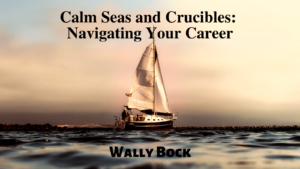Lots of things have changed since I was coming up. For one thing, phones don’t plug into the wall anymore. In fact, most of us carry around a device that’s a computer and a phone. What we expect of leadership has changed, too. And artificial intelligence is beginning to do some of our work for us.
Two things haven’t changed, though. We still must get the job done with people, complete with all their strengths and foibles. And our days seem to alternate between periods of calm and consolidation and periods of crisis and great growth.
That’s what you’ll confront as you move ahead in your career, no matter how many years you have left. You might choose leadership as your calling and climb a corporate ladder or two. Or you might slide around the lattice, taking new opportunities as they arise. Either way, your world will alternate between calm and crisis.
Leadership and self-help authors may leave the impression that your growth will be consistent and steady. Don’t believe it. Expect calm periods to be followed by crises. Expect that pattern to repeat.
Easy Evolution
Easy times can lull you into a sense of false security. Don’t sit back and relax. Use the period of calm to prepare for the inevitable crises.
Hone your daily routine to a fine edge. Practice making learning a part of every day.
Develop your ability to spot the faint signals of major change. Read widely about leaders, the world, and your industry or trade. You’ll learn steadily and incrementally so you’ll be ready when the next crisis hits.
Crises and Crucibles
You may have heard the term “crucible.” Warren Bennis and Robert Thomas coined it for situations that were difficult but held the promise of growth. Great growth. Explosive growth.
Usually, a crucible is imposed from outside. It might be an emergency. It might be an assignment or a position where, at first, you don’t know how you will get the job done.
Foreseeable Crises
You can see some crises coming, like a storm on the ocean. Every new promotion or new job will require you to do things differently. As Marshall Goldsmith said, “What got you here won’t get you there.”
Use calm times to develop the mindset and skills that will help you in a new position. Study people who have been successful in similar positions. Reflect on how you might do what they did, but with your personality and in your situation.
Surprise! You’re in a crucible!
When a crisis hits, it’s too late to prepare. Don’t waste time shaking your fist at the sky or wishing for things to be the way they were. Behaviors like that suck up valuable time that you need to deal with the crisis.
Take a deep breath and assess the situation and your readiness. The most important thing you should be doing has probably changed. What is it now? What must you learn and do to meet the crisis effectively? Ask the question my mother asked whenever she was in a crisis. “What good can we make of this?”
When the crisis is over, reflect and learn. Identify new skills you’ve mastered and how you might use them. Identify what you learned about how you learned and how you can use that going forward.
Most lives and careers alternate periods of calm and periods of crisis. The calm times are for preparing and developing good habits. The crisis times should be times of intense learning and development.
Takeaways
Calm situations give way to crises which give way to calm.
Change is required for growth and change is not comfortable.
Use calm times to develop good habits.
Use calm times to develop your ability to spot faint signals.
Prepare for foreseeable crises.
Crucibles are opportunities for great growth and learning.
Growth and development are not smooth processes.



There are no comments yet, why not be the first to leave a comment?